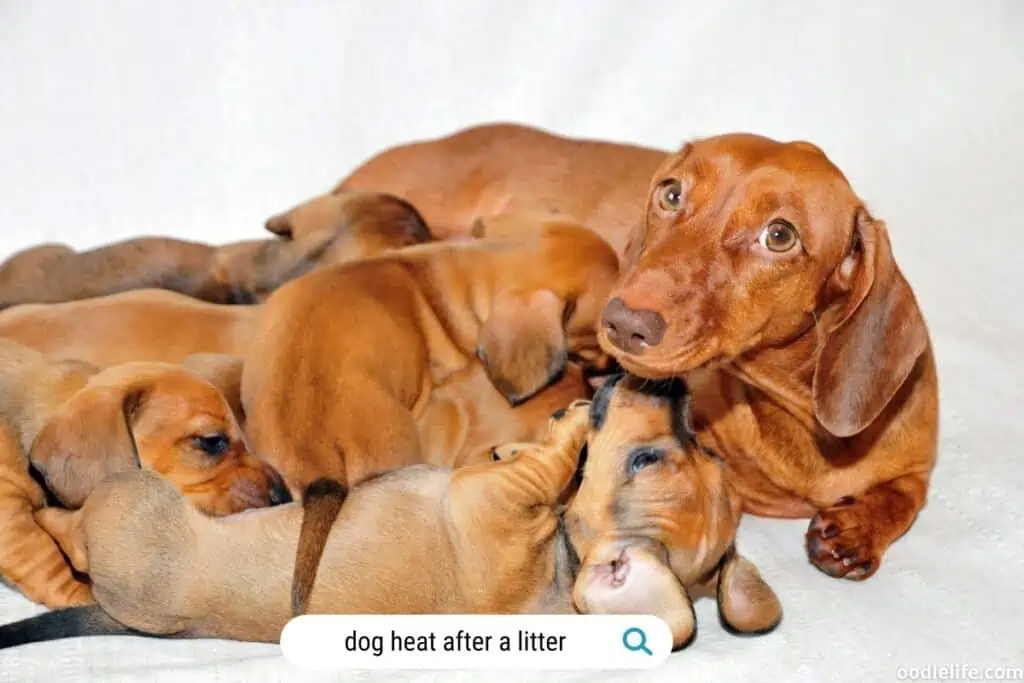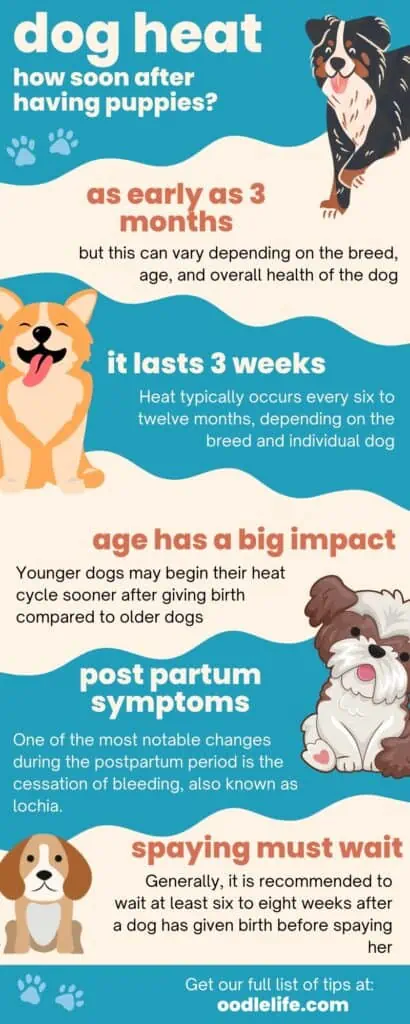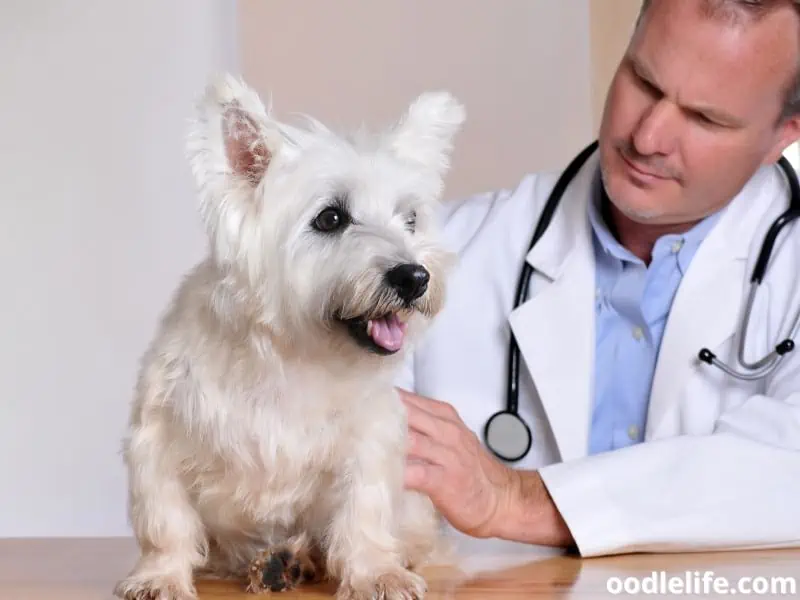When Does a Dog Go Into Heat After Having Puppies (Guide)
Many dog owners wonder how soon their dog can go into heat after having puppies. While the answer is not straightforward, there are several factors that can influence the timing of a dog’s next heat cycle.
Firstly, rest assured knowing you are not alone in asking this question. As a family dog expert, I get asked about heat after litters all the time. Even those with experience in breeding often double-check or wonder about breed-specific quirks.
Generally, dogs can go into heat as early as three months after giving birth, but this can vary depending on the breed, age, and overall health of the dog.

It’s important to note that breeding a dog too soon after giving birth can be dangerous for the mother and her puppies, and it’s recommended to wait until at least six months after the birth before considering trying for dog pregnancy again.
In addition to the physical health of the mother, other factors that can affect the timing of a dog’s next heat cycle include environmental factors such as temperature and daylight hours, as well as stress levels and hormonal imbalances.
Understanding these factors can help a pet parent better prepare for their pet’s health and make informed decisions about breeding and spaying.

What is Heat in Dogs?
Heat, also known as estrus, is a natural reproductive cycle in female dogs. During this period, the dog’s body prepares for mating and pregnancy. Heat occurs when the ovaries release eggs, and the lining of the uterus thickens in preparation for pregnancy. If the dog does not mate, the lining of the uterus is shed, and the dog will go out of heat.

Heat typically occurs every six to twelve months, depending on the breed and individual dog. The duration of heat can vary from dog to dog, but it usually lasts for around three weeks. During this time, the dog may exhibit certain behaviors, such as increased urination, restlessness, and a heightened interest in male dogs.
It’s important to note that not all dogs experience heat in the same way. Some may have more pronounced symptoms, while others may show no outward signs at all. Additionally, spayed dogs will not go into heat as their ovaries have been removed.
The Heat Cycle in Dogs
After giving birth to puppies, female dogs can go into heat as early as two months after delivery. This is unlikely though. However, this can vary depending on the breed and individual dog.
The heat cycle in dogs, also known as estrus, is the period of time when a female dog is receptive to mating. It typically occurs every six to eight months, but can vary from dog to dog. The cycle can last anywhere from two to four weeks and is divided into four stages:

- Proestrus: This is the first stage of the heat cycle and usually lasts for about nine days. During this time, the female dog’s may have a bloody discharge. She may also become more restless and seek attention from male dogs, but will not yet be ready to mate.
- Estrus: This is the second stage of the heat cycle and lasts for about nine days as well. During this time, the female dog will be receptive to mating and may actively seek out male dogs. Her discharge may become lighter in color and she may exhibit other signs, such as a change in behavior or posture.
- Diestrus: This is the third stage of the heat cycle and lasts for about 60 days. During this time, the female dog’s reproductive system will return to its normal state if she did not mate. If she did mate, she may become pregnant and enter gestation.
- Anestrus: This is the fourth and final stage of the heat cycle and lasts for about 120 days. During this time, the female dog’s reproductive system is at rest and she will not go into heat.
It is important to note that spaying a female dog can prevent her from going into heat and reduce the risk of certain health issues, such as uterine infections and tumors.
Factors Affecting the Heat Cycle
After giving birth, female dogs typically undergo a period of rest and recovery. During this time, their reproductive system takes a break, and they do not go into heat. However, the length of this break can vary depending on several factors.

One of the primary factors that affect the heat cycle after giving birth is the age of the dog. Younger dogs may begin their heat cycle sooner after giving birth compared to older dogs. Additionally, the breed of the dog can also play a role in how quickly they return to their heat cycle. Some breeds may take longer to recover than others.
Extremely small and extremely large dogs are outliers that tend to take LONGER to recover. So be kind and patient with a teacup Pomeranian or a Great Dane.
The size of the litter can also impact the timing of the heat cycle. Dogs with larger litters may take longer to recover and return to their heat cycle. This is because their bodies require more time to recover from the demands of pregnancy and birth.
Finally, the health of the dog can also impact the timing of the heat cycle. Dogs that experience complications during pregnancy or birth may take longer to recover and return to their heat cycle. It is important to monitor the health of the dog closely during this time and seek veterinary care if any issues arise.
Postpartum Period in Dogs
After giving birth, female dogs enter a postpartum period where their body goes through a series of changes. During this time, it is important for dog owners to be aware of the signs and symptoms to ensure their dog’s health and well-being.
This means keeping an eye out for some obvious signs – and a few behavioral signs also. Knowing your dog well goes a LONG way to understanding the phase they are in.
One of the most notable changes during the postpartum period is the cessation of bleeding, also known as lochia. This typically lasts for around three weeks, but can vary depending on the individual dog. It is important to monitor the amount of bleeding, as excessive bleeding can be a sign of complications.
Another change during the postpartum period is the return of the dog’s heat cycle. While it is possible for a dog to go into heat as early as two weeks after giving birth, it is more common for it to occur around six to eight weeks after delivery. It is important to keep the dog away from intact males during this time to prevent unwanted pregnancy.
During the postpartum period, it is also important to monitor the dog’s appetite and behavior. Some dogs may experience a decrease in appetite or become lethargic, which can be a sign of complications. It is important to consult with a veterinarian if any concerning symptoms arise.
In conclusion, the postpartum period is a crucial time for female dogs and their owners. By staying aware of the changes and symptoms, owners can ensure their dog’s health and well-being during this time.
When Does a Dog Go into Heat After Having Puppies?
After a dog gives birth to puppies, the body goes through a recovery process. During this time, the dog is not able to go into heat. The length of this recovery period varies depending on the individual dog, but it typically takes around 6-8 weeks for the dog to fully recover from giving birth.

After the recovery period, a dog can go into heat at any time. However, it is important to note that it is not recommended to breed a dog during her first heat cycle after giving birth. This is because the dog’s body needs more time to fully recover and regain its strength before going through another pregnancy.
It is also important to keep in mind that breeding a dog too soon after giving birth to even one puppy can lead to health complications for both the mother and the puppies. It is recommended to wait at least 6 months after giving birth before breeding a dog again.
Spaying after a litter
Spaying, or ovariohysterectomy, is a surgical procedure to remove a female dog’s reproductive capacity. Generally, it is recommended to wait at least six to eight weeks after a dog has given birth before spaying her.
If you are breeding, it quite simply must be done in an ethical manner. See these Purdue University example standards. If you cannot meet, them, DO NOT BREED YOUR DOG.
This allows her body to fully recover from pregnancy and delivery before undergoing anesthesia and surgery. However, the exact timing may vary based on the individual dog’s health status and the veterinarian’s advice.
Additionally, if the dog is still showing any signs of complications after giving birth, spaying may need to be postponed until she is in better health. It’s important to discuss the timing of spaying with a veterinarian and carefully consider the potential risks and benefits of the procedure for each individual dog.
Conclusion
After giving birth, it is essential to monitor the dog’s behavior and physical changes closely. Dogs can go into heat as early as two weeks after giving birth, but it is more common for it to happen between four to six months. However, it is essential to remember that every dog is different, and factors such as breed, age, and health can affect the timing of their heat cycle.

An older dog will need longer to recover and the season may never return. This is a normal part of aging! Priority number one must ALWAYS be the safety and wellbeing of the mother.
It is crucial to consult with a veterinarian to determine the best course of action for your dog’s reproductive health. Spaying or neutering your dog can prevent unwanted pregnancies and reduce the risk of certain health issues. Additionally, keeping your dog away from unneutered males (I cannot emphasize this enough) during their heat cycle is essential to prevent unwanted breeding.
Overall, it is important to be aware of the signs of heat in dogs and to take the necessary precautions to ensure their health and well-being. By staying informed and working closely with your veterinarian, you can help ensure that your dog stays healthy and happy for years to come.
